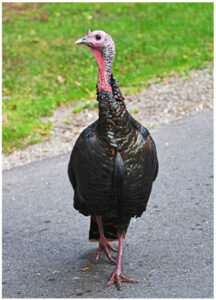
Rural Perspectives: The wild turkey (Meleagris gallopavo)

by Diane Constable
These large birds, up to 25 pounds with a 4-foot wingspan, are now a common sight in the township —but they weren’t always so visible. The wild turkey had disappeared from Michigan in the early 1900s because of habitat loss and overhunting.
In the 1950s, the Department of Natural Resources acquired several dozen turkey chicks and began to slowly build up the numbers. This has been called the most successful reintroduction of a species in Michigan. By the 1980s, the birds had been gradually reintroduced throughout the state. The Michigan flocks now contain more than 200,000 birds.
Historically, turkey fossils have been found that are up to 5 million years old. The bird was domesticated by Central American natives nearly 2,000 years ago. Early Spanish explorers of the region took the birds back to Europe in the 1500s, where they became a favorite food source.
The female, called a jenny or hen, nests on the ground by scratching an inch-deep depression and gathers nearby leaves and other plant materials to make her nest. The chicks, called poults, are born ready to feed themselves and leave the nest within a day of hatching. The group’s 10-15 poults stay with the hen for their first summer, often combining with another hen and brood.
The birds eat various grass seeds, grains, nuts, acorns and berries. At night, they will often roost in trees to avoid predators. Although they are ground birds, they are strong flyers for short distances and can reach up to 55 miles per hour.
Wild turkeys are covered with about 5,000 feathers, which can range from deep brown to various shades of gray and sometimes white. The males, called toms, have leg spurs for defense, which continue to grow throughout their 3- to 4-year life.
Fun Fact: When startled, male turkeys are more likely to run, while females are prone to take flight.




